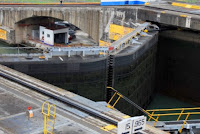
OAt the Spring Festival in Nagasaki with some of the locals
 Puccini was inspired to write Madama Butterfly by events in what is now Glover Garden
Puccini was inspired to write Madama Butterfly by events in what is now Glover Garden

Schoolgirls on Holiday in Nagasaki

Artificial Food Display Outside A Restaurant

Do I HAVE to do this
 Getting ready to perform at the Spring Festival
Getting ready to perform at the Spring Festival
 Industrial Art
Industrial Art

Life imitating Art in Glover Garden
We visited two cities in Japan, Kobe and Nagasaki, each with distinctly different personalities.
If Kobe seems to have a familiar ring to it, yes, it is the home of Kobe beef. A very modern and dynamic city, it has had to reinvent itself twice in recent history. It was badly bombed toward the end of world War 11, sustaining extensive physical damage and loss of life. Fully recovered and thriving it was again devastated in 1995 by a severe earthquake; 7 + on the Richter scale. Some of you may remember the earthquake. It made world news because many bridges buckled and collapsed, making recovery efforts difficult.
Fully rebuilt, it is a beautiful world class metropolis. The many teenagers bubble with energy and happiness. Children of an affluent society, they have a funky, fashionable, attractive dress code of their own. Lots of short shorts, knee high boots, mini skirts and outrageously wonderful tops, all coordinated with a balance of color and style uniquely Japanese. The center of the city is one large shopping center with every well known retailer present, side by side with local shops and boutiques. It was a joy to get lost there, window shopping and people watching. No purchasing allowed, mind you. The rate of exchange made everything in Japan very expensive!
Nagasaki is different. The pace of life is slower, the atmosphere more traditional. There is a quiet elegance. For many years it was the only port of entrance for visitors to Japan. Sadly Nagasaki has also had to reinvent itself because of the atomic bomb. Unlike Kobe, it elected to restore and preserve its inheritance. Some of the temples, originally built by the Chinese merchants and mariners, have been restored to their former splendor. Havens of quiet beauty, they encourage peaceful reflection.
Mal and I visited Glover Garden while in Nagasaki. Glover was one of Japans first foreign entrepreneurs. The estate is on a hill overlooking the bay. Supposedly it was the inspiration for Puccini’s opera,
Madama Butterfly. I had difficulty clarifying if Puccini actually visited the garden, but there is a statue of him, and also one of a famous Japanese opera star who is identified with the role of Butterfly.
I took the opportunity to persuade Mal to find a Japanese steak house so that I could taste some Kobe beef. It is, indeed, deliciously tender, but not worth the premium price exacted by New York restaurants.








+5-7-2008+12-17-20+PM+3872x2592.JPG)










.jpg)








